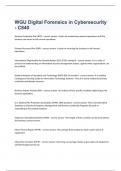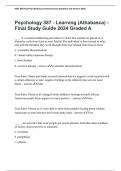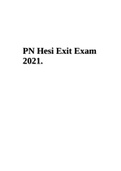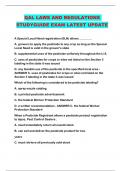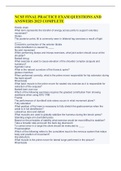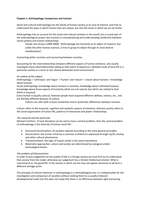Democrat factions: liberals/ progressive, moderates/ centrists, conservatives.
Republican factions: moderates, fiscal conservatives, social conservatives.
,Evaluate the extent to which interest groups benefit democracy
An organised body whose members hold similar beliefs and actively pursue ways to influence
government.
Through them, citizens can participate in the political process between elections
Benefits from access points.
Overall: benefit democracy
Representation Representation isn’t democratic
Provide a channel of easy access through Many pressure groups represent minorities
which citizens can voice their opinions. in society, creating a ‘tyranny of the
Senators and representatives have many majority’, where minority views are given
calls upon them- different constituents, more weight than everyone else.
their political party and the administration, Also represents those with close links to the
so interest groups provide better government and wealth most.
representation as can just focus on the Eg. Many Americans and Congressmen
specific issue/ sectional group of society. agree there should be stricter gun control
Interest groups represent views in all 3 laws, the immense power of the NRA has
branches of gov, in federal, state and local kept this from happening.
levels.
Eg. National Farmers’ Union- represents the
interests of US agriculture.
Encourage citizens participation Participation is bad
Elections in the US aren’t common, being May encourage members to partake in
just once every 2 years for Congress and 4 violent and illegal activity that opposes
years for the president, and many democracy.
Americans wish to participate more. Eg. The National Association for the
Allows citizens to participate in a specific Advancement of Colored People occupied
policy area they feel deeply about- eg. pro- the offices of a senior Republican politician
gun, anti-abortion. in North Carolina, disrupting the
Members will often write letters, email representative process.
legislators or utilise social media to Many wealthy groups are rumoured go take
publicise and advance their cause. part in illegal behind the scene activity such
Eg. EMILY’s List which advocates for the as giving bribes to Congress members in
legal right to an abortion- has raised over exchange of support.
$700 million to help Democrat women
candidates to win elections.
Check the work of government Restrict elected government
Check gov to reduce corruption and misuse Interest groups have wide support, but no
of power. electoral mandate, so opposition to policy
Eg. the American Civil Liberties Union helps undermines the representative process.
protect the civil liberties of various groups Eg. the American Association of Retired
in society, like LGBT rights. People attempted to stop Obama passing
the Affordable Care Act even though it was
a key policy in his campaign.
,Evaluate the view that race is the most important social factor in influencing behaviour
Social factors refer to the social characteristics of voters, which influence their voting behaviour.
Including race, religion and gender.
Overall: other social factors are more important
Race does influence Race doesn’t influence
Black voter trends. Hispanic voter trends.
Obama was first black American presidential for a Trump on Mexican immigrants: “they’re bringing
major party in 2008. drugs, they’re bringing crime, they’re rapists”,
2004- 88% of black people voted democrat, 2008- promised to build a wall to keep illegal Mexican
95% of black people voted Democrat. immigrants out of the US.
Black turnout increased 2004-2008, now accounted Despite this attitude, over 25% of Hispanic voters
for 13% of the electorate. voted for Trump in 2016, and the Hispanic
Republican vote increased by 1% compared to
2012.
Religion does influence Religion doesn’t influence
64% of Muslim voters voted for Biden in 2020. In 2020, 47% of Catholics voted for Trump,
Traditional bias of Muslims towards the Democrats, compared to 52% who voted for Biden.
can be explained through their more progressive Hence, no trends between religion and voting can
policies, promoting social inclusion. be established, as the two parties are very
Others think this is just a reaction to Trump’s polarised on key ideological issues.
comments and policies. → Clear trend amongst white evangelicals, with
Eg. the travel ban which affected 7 Muslim majority 76% voting for Trump in 2020, compared to
states and when he stated “I think Islam hates us.” 24% who voted for Biden.
Gender does influence Gender doesn’t influence
Democrats tend to take positions favoured by Gender doesn’t definitely define voting, instead
women on 5 key issues- gun control, abortion (pro- people vote based on personal belief.
choice), defence (favour lower levels of spending Many women still vote for the Republican Party,
on defence), law and order (oppose capital despite views on abortion, due to ideological belief.
punishment and support gun control) and women’s Studies show that moderately masculine men are
rights (legislation). equally/ more liberal than women on a variety of
Eg. Democrats, unsuccessfully, pushed for an equal issues, from same-sex marriage to social spending,
rights amendment to the Constitution protecting hence don’t share Republican Party’s position on
the civil rights of women. issues like gun rights, and he backlash against
High number of high-profile female politicians. ‘identity politics’.
Eg. Kamala Harris, first woman to ever hold the Statistica: 43% of adults in 2023 stated that they
office. strongly disapprove of the SC decision to overturn
Trump: video emerged before election day showing Roe v Wade, may explain why the Democrats
him bragging about kissing, groping and trying to retained control of the Senate during 2022
have sex with different women, led to a 3% fall in midterm elections.
votes from women compared to 2012.
Education does influence Education doesn’t influence
In 2020, 54% of high school graduates voted for Race is ultimately the more determining factors.
Trump, compared to 46% who voted for Biden. In 2020, 48% of white college graduates voted for
In 2020, 37% of post graduate voters voted for Trump, compared to 51% of white college
Trump, compared to 62% who voted for Biden. graduates who voted for Biden.
The trend is increasing, with an 8% swing to the Shows that race is a more significant factor, as
Democrats from the 2016 to 2020 election. voting patterns were an almost 50%/50% split.
This is because more educated voters tend to be
more liberal on social issues, explained by the fact
that education tends to increase one’s exposure to
different viewpoints and kinds of people, fostering
tolerance.
, Evaluate the extent to which attempts to regulate campaign finance have been successful
Campaign finance refers to how political parties raise and spend money for their political campaigns,
Overall: attempts have been unsuccessful
Bipartisan Campaign Reform Act Bipartisan Campaign Reform Act
Stated that national political party committees Reforms were unsuccessful, because parties
can no longer receive “soft money”- money instead raised more hard money- money directly
donated indirectly to political parties and donated to a political party or an individual
political action committees, thus not tightly candidates’ campaign.
regulated by law. National political parties raised more hard
Set individual limits on contributions to money in 2003, than they did soft and hard
individual candidates or candidate committees money in 1999.
at $2,3000, which can be increased with Eg. $371 million in hard money 2003, $266 hard
inflation in ‘odd years’. and soft money in 1999.
Eg. 2008, 527 groups didn’t spend as much due Furthermore, the 2004 presidential election saw
to rules surrounding donations coming as hard new ‘527 groups’ emerge- tax exempt political
money. organisations that can raise and spend unlimited
amounts of money for political activities.
Eg. ‘America Coming Together’ which raised and
spent millions of dollars, most which was
donated by a few super-rich people.
Less comes from huge donors Citizens United v. Federal Election Commission
57% of individual donations to the Obama Ruled in the 5-4 decision that laws which
campaign in 2012 were made up of prevented corporations and unions from using
contributions under $200. their general treasury funds for independent
“electioneering communications”- political
advertising- violated the First Amendment’s
guarantee of freedom of speech.
This invalidated Section 203 of the federal
Bipartisan Campaign Reform Act of 2002.
Led to the rise of ‘independent expenditure’
(money not raised/ spent directly by the
candidate themselves), such as Super PACs.
2020, outside spending by Super PACs and other
big-money groups totalled nearly $1.2 billion.
Federal Election Campaign Act FEC
FEC administers matching funds- federal money Presidents can choose to ‘opt out’, showing that
administered to presidential candidates who regulations are unsuccessful, because presidents
meet certain criteria and agree to certain limits. whom opt out of the funding also opt out of the
Eg. 1976 presidential election, FEC paid out over regulations to campaign finance.
$72 million in matching funds. Eg. 2008, Obama opted out of matching funds,
leaving him free from the fundraising and
spending limitations imposed by the FEC, thus
was able to significantly outspend his
Republican opponent McCain, who took the $84
million in matching funds for his GE campaign.
Presidents also don’t always follow it.
Eg. NRA is being sued for not complying, as it is
said they made $35 million + in campaign
contributions unlawfully.

